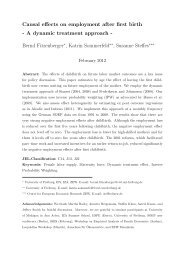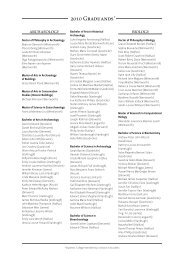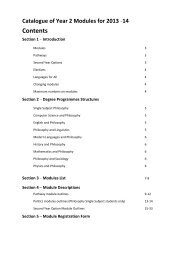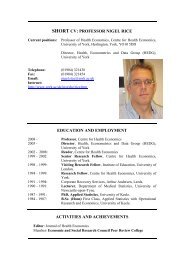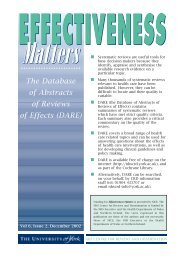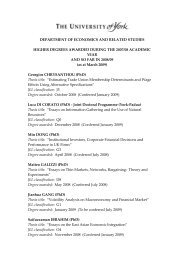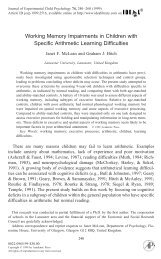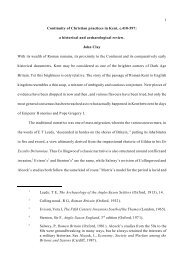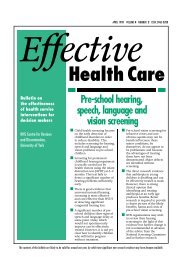Marie-Catherine de Marneffe, Uriel Cohen Priva ... - University of York
Marie-Catherine de Marneffe, Uriel Cohen Priva ... - University of York
Marie-Catherine de Marneffe, Uriel Cohen Priva ... - University of York
Create successful ePaper yourself
Turn your PDF publications into a flip-book with our unique Google optimized e-Paper software.
A statistical mo<strong>de</strong>l <strong>of</strong> grammatical choices in children’s<br />
productions <strong>of</strong> dative sentences<br />
<strong>Marie</strong>-<strong>Catherine</strong> <strong>de</strong> <strong>Marneffe</strong>, <strong>Uriel</strong> <strong>Cohen</strong> <strong>Priva</strong>, Scott Grimm,<br />
San<strong>de</strong>r Lestra<strong>de</strong> ∗ , Gorkem Ozbek, Tyler Schnoebelen, Susannah Kirby ∗∗ ,<br />
Misha Becker ∗∗ , Vivienne Fong and Joan Bresnan<br />
Stanford <strong>University</strong>, Nijmegen <strong>University</strong> ∗ , <strong>University</strong> <strong>of</strong> North Carolina at Chapel Hill ∗∗<br />
{mcdm, urielc, sgrimm, gorkem, tylers, vivienne, bresnan}@stanford.edu<br />
s.Lestra<strong>de</strong>@let.ru.nl, suki@metalab.unc.edu, mbecker@email.unc.edu<br />
The driving forces behind variation in the dative construction have stood as a puzzle both from the<br />
point <strong>of</strong> view <strong>of</strong> child language acquisition and in the theoretical syntactic literature addressing adult production.<br />
One line <strong>of</strong> thought attributes these choices to lexical meaning differences among dative verbs<br />
((Gropen et al., 1989) for children; (Green, 1971) for adults) or to constructional differences in meaning<br />
that constrain verb choice (Goldberg, 1995). But studies <strong>of</strong> actual usage are increasingly showing that<br />
the mapping between meanings and construction choice is much more flexible than these earlier studies<br />
allowed (Sny<strong>de</strong>r, 2003; Bresnan & Nikitina, 2003). Additionally, usage studies point to the important<br />
role <strong>of</strong> properties such as end weight and pronominality in <strong>de</strong>termining construction choice for adults<br />
(Thompson, 1990; Collins, 1995; Wasow, 2002; Bresnan & Hay, 2006).<br />
Given the <strong>de</strong>terminative role <strong>of</strong> verb meanings in previous theories <strong>of</strong> child acquisition <strong>of</strong> dative<br />
structures (Pinker, 1989), an important question is whether the same usage factors <strong>of</strong> end-weight and<br />
pronominality that affect the meaning-to-syntax mappings for adults also influence variation in child<br />
dative construction choice. Recently, statistical mo<strong>de</strong>ls <strong>of</strong> grammatical choices in adults’ syntactic productions<br />
have given rise to the possibility <strong>of</strong> predicting variation based on factors well-known to influence<br />
production (e.g., animacy) (Arnold et al., 2000; Szmrecsanyi, 2005; Becker, 2006; Bresnan & Hay,<br />
2006). Building upon the work <strong>of</strong> (Bresnan et al., 2005) which analyzes dative alternation in adult speech<br />
by means <strong>of</strong> logistic regression techniques, this paper <strong>de</strong>velops a comparable analysis for the dative alternation<br />
in child speech. Our findings <strong>de</strong>monstrate that the same mo<strong>de</strong>ling techniques are predictive for<br />
the children’s production data; however, the prepon<strong>de</strong>rant factors differ across mo<strong>de</strong>ls.<br />
We based our study on data from a subset <strong>of</strong> the Child Language Data Exchange System (MacWhinney,<br />
2000). Seven children from this database were selected based on the amount <strong>of</strong> data available, both<br />
the total utterances and those containing dative constructions. The data was annotated for a variety <strong>of</strong><br />
factors known to influence adults’ production <strong>of</strong> datives, namely: animacy, length, pronominality, givenness<br />
and persistence. Further, age and mean length utterance (MLU) were co<strong>de</strong>d as approximate measures<br />
<strong>of</strong> <strong>de</strong>velopmental progress. These factors were then used in a logistic regression mo<strong>de</strong>l (Baayen,<br />
2006), which is well-suited to characterize binary classification tasks. This mo<strong>de</strong>l evaluated each factor’s<br />
strength as a predictor <strong>of</strong> the dative construction being realized as NP PP rather than NP NP.<br />
The resultant mo<strong>de</strong>l is valuable in itself as <strong>de</strong>monstrating the multi-variable nature <strong>of</strong> children’s language<br />
production. Lengths <strong>of</strong> the theme and the recipient as well as the pronominality <strong>of</strong> the theme were<br />
found to be significant predictors. Another factor which was found to be significant, persistence, measures<br />
whether a previous dative construction influences the construction un<strong>de</strong>r consi<strong>de</strong>ration. In contrast,<br />
age and MLU were not predictive factors, consistent with the general findings in language acquisition<br />
(Clark, 2003). In addition, comparison with the mo<strong>de</strong>l <strong>of</strong> (Bresnan et al., 2005) yields interesting distinc-
tions which may characterize the difference between child and adult grammars. In particular, length and<br />
pronominality behave similarly across mo<strong>de</strong>ls, revealing a significant end-weight effect among children.<br />
However, animacy, which is a strong predictor in the adult mo<strong>de</strong>l, was not found to be significant for<br />
children, although a full comparison would require further study. Given the size <strong>of</strong> the corpus, our results<br />
are promising rather than <strong>de</strong>finitive; yet the resulting mo<strong>de</strong>l assesses on empirical grounds the predictive<br />
power <strong>of</strong> linguistically motivated factors to account for syntactic variation, <strong>de</strong>monstrating that the application<br />
<strong>of</strong> robust statistical mo<strong>de</strong>ling techniques can yield insight into the factors at play in children’s<br />
speech production.<br />
References<br />
ARNOLD, J., WASOW, T., LOSONGCO, A., & GINSTROM, R. 2000 Heaviness vs. newness: The effects <strong>of</strong><br />
complexity and information structure on constituent or<strong>de</strong>ring. Language, 76, 28–55.<br />
BAAYEN, H. 2006 Practical Data Analysis for the Language Sciences with R. (forthcoming).<br />
BECKER, M. 2006 Animacy, Expletives, and the Learning <strong>of</strong> the Raising-Control Distinction. In Generative<br />
Approaches to Language Acquisition North America 2.<br />
BRESNAN, J., CUENI, A., NIKITINA, T., & BAAYEN, H. 2005 Predicting the Dative Alternation. In BOUME,<br />
G., KRAEMER, I., & ZWARTS, J. (editors), Cognitive Foundations <strong>of</strong> Interpretation, Amsterdam: Royal<br />
Netherlands Aca<strong>de</strong>my <strong>of</strong> Science.<br />
BRESNAN, J. & HAY, J. 2006 Gradient grammar: an effect <strong>of</strong> animacy on the syntax <strong>of</strong> ‘give’ in varieties <strong>of</strong><br />
English. to appear in Lingua.<br />
BRESNAN, J. & NIKITINA, T. 2003 On the Gradience <strong>of</strong> the Dative Alternation. ms.<br />
CLARK, E. 2003 First Language Acquisition. Cambridge <strong>University</strong> Press.<br />
COLLINS, P. 1995 The indirect object construction in English: an informational approach. Linguistics, 33, 35–49.<br />
GOLDBERG, A. 1995 Constructions: A Construction Grammar Approach to Argument Structure. Chicago:<br />
<strong>University</strong> <strong>of</strong> Chicago Press.<br />
GREEN, G. 1971 Some implications <strong>of</strong> an interaction among constraints. In Papers from the Seventh Regional<br />
Meeting, Chicago Linguistic Society, 85–100, The <strong>University</strong> <strong>of</strong> Chicago.<br />
GROPEN, J., PINKER, S., HOLLANDER, M., GOLDBERG, R., & WILSON, R. 1989 The learnability and<br />
acquisition <strong>of</strong> the dative alternation in English. Language, 65, 203–257.<br />
MACWHINNEY, B. 2000 The CHILDES Project: Tools for analyzing talk. 3rd Edition. Vol. 2: The Database.<br />
Lawrence Erlbaum Associates.<br />
PINKER, S. 1989 Learnability and Cognition: The acquisition <strong>of</strong> Argument Structure. Cambridge, Mass.: MIT<br />
Press.<br />
SNYDER, K. 2003 The relationship between form and function in ditransitive constructions. PhD thesis, Phila<strong>de</strong>lphia:<br />
<strong>University</strong> <strong>of</strong> Pennsylvania Department <strong>of</strong> Linguistics.<br />
SZMRECSANYI, B. 2005 Language users as creatures <strong>of</strong> habit: A corpus-based analysis <strong>of</strong> persistence in spoken<br />
English. Corpus Linguistics and Linguistics Theory, 1, 113–150.<br />
THOMPSON, S. 1990 Information flow and dative shift in English discourse. In EDMONDSON, J. A., CRAW-<br />
FORD, F., & MUHLHAUSLER, P. (editors), Development and Diversity, Language Variation Across Space<br />
and Time, 239–253, Summer Institute <strong>of</strong> Linguistics, Dallas, Texas.<br />
WASOW, T. 2002 Postverbal Behavior. Stanford: CSLI.



